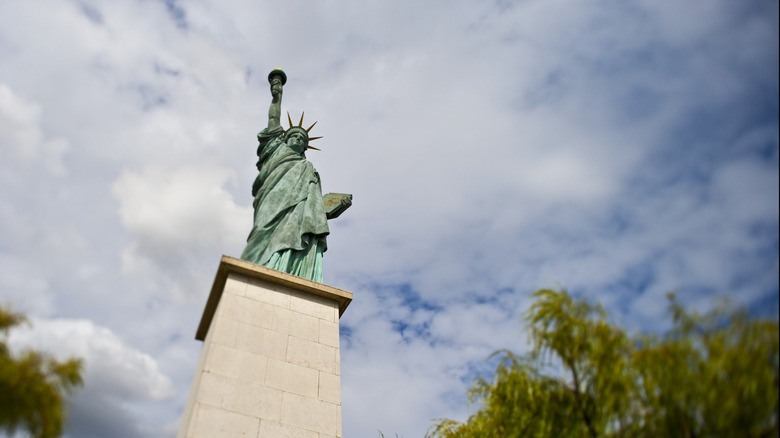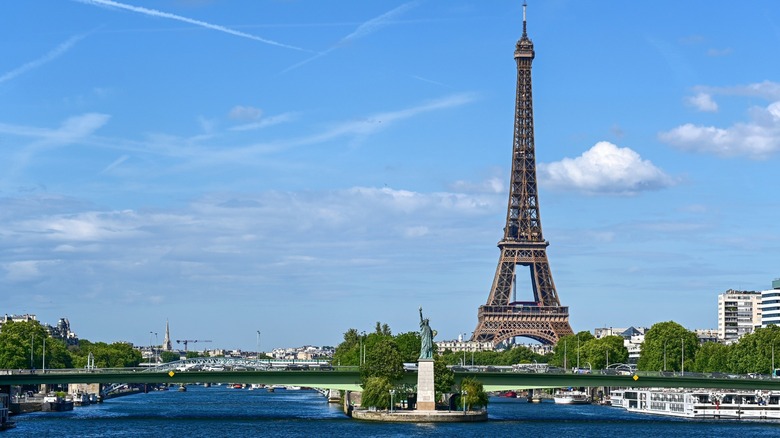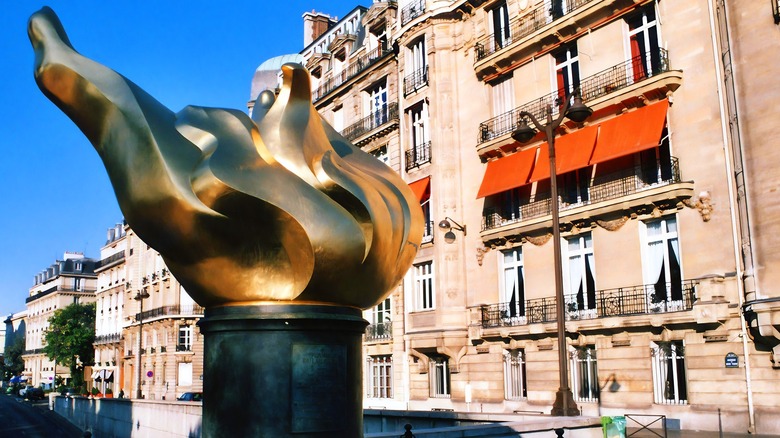An Iconic International City Hides Mini Statues Of Liberty In Homage To Its Connection To New York
More than 20 towns in the United States have borrowed their name from France's capital, including the world's "second-largest Paris," a cute Texas town with its own Eiffel Tower, and the smaller town of Paris, Arkansas, which is also home to a miniature Eiffel Tower replica. Despite sharing a name with the European city, it's easy to wonder why these towns are so intent on recreating a landmark that belongs so clearly to just one place.
You could ask Parisians the same thing. As you look around their centuries-old streets, you may discover an icon of American history normally spotted in the New York Harbor. That's right: Paris, France, is home to not one, not two, but as many as eight replicas of Lady Liberty. The statue is a treasured symbol of New York and an item that, in the minds of millions, distinctly belongs to America. Yet the relationship between the French and the Americans, and their collaborative approach to creating the Statue of Liberty, tell a story that brings the two places closer than the ocean between them would suggest.
Symbols of France's friendship with America can be found in both countries
The reciprocity between the French and Americans began during the American Revolutionary War, when France provided ammunition and supplies, as well as loans that helped stabilize the newly independent United States of America. Nearly a century after the Declaration of Independence was signed — and shortly after the Civil War ended slavery in the United States — a Frenchman, Édouard de Laboulaye, had the idea to collaborate on a gift celebrating the U.S. centennial. Along with French sculptor Frédéric-Auguste Bartholdi and the engineering support of Alexandre Gustave Eiffel — who had not yet designed his iconic Parisian tower — the statue was designed, built, and funded in France; the pedestal upon which it was placed was built in America. In 1886, the statue was finally assembled and dedicated in New York on Liberty Island.
Just a few years later, Americans in Paris gifted a quarter-scale replica of the Statue of Liberty to France in honor of the country's own revolutionary centennial in 1889. The statue, located on the Allée aux Cygnes facing the Eiffel Tower, is accessible from Pont de Grenelle and Pont Bir-Hakeim. There's stair access from the bridges to the narrow strip of island in the Seine, on the end of which you'll find little sister Liberty.
The Pont de Grenelle Statue of Liberty, standing nearly 38 feet tall, is the largest replica in Paris, but by no means is it the only one worth visiting. In fact, if you know where to look, you'll spot a Statue of Liberty just across the water from the Eiffel Tower. Instead of counting the most recognizable "Emily in Paris" filming locations during your next trip to France, make it your quest to spot some of the many Parisian homages to Franco-American friendship.
Lady Liberty lives all across the City of Light
Given all that the Statue of Liberty represents, finding its replicas in Paris is like tracing an international art project across time and space. The Left Bank's Jardin du Luxembourg, a park that is home to 102 statues honoring 19th-century authors, musicians, queens, and political figures, features a contemporary replica of the statue at its western edge, opposite 3 Rue Guynemer. Curiously, this statue is a copy of a copy: The O.G. Statue of Liberty's sculptor, Frédéric Bartholdi, built a mini statue for the World Expo of 1900 that was later displayed in front of the Musée du Luxembourg (situated inside Jardin du Luxembourg). That one was taken to the Musee d'Orsay in 2014, leaving the park to create another replica. Bartholdi's 1900 statue can be viewed in the Allée centrale des sculptures of the Musée d'Orsay at Esplanade Valéry Giscard d'Estaing.
After wandering the streets of Paris' oldest district, you'll be just blocks away from another Lady Liberty inside the Musée des Arts et Métiers. It's a fascinating museum devoted to artifacts of French and international technology and invention. Its 9-foot tall plaster model statue was one of the original prototypes for the Statue of Liberty and came to the museum via a donation by Bartholdi's wife in 1907.
Other small statues can be seen throughout the city, but the last model we recommend can be found on the right bank of Pont de l'Alma. This time, it's an at-scale replica of the Statue of Liberty's flame, the shiny, gold torch that tops the figure. It was a gift from the International Herald Tribune on the centennial of the dedication of the Statue of Liberty itself, bringing this exchange truly full circle.


